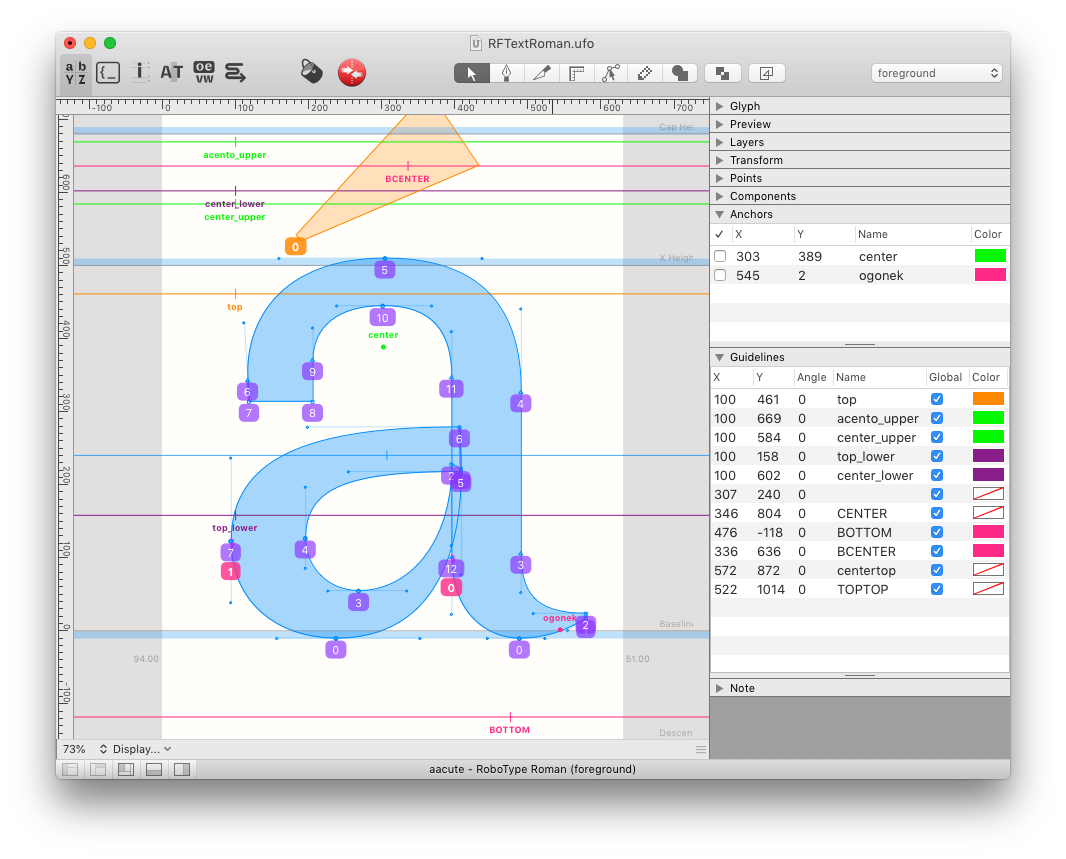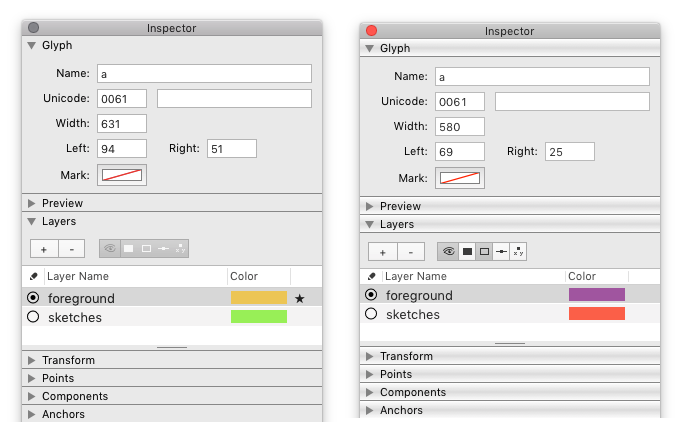RoboFont 3.3
-
Today we’re proud to announce the official release of RoboFont 3.3, wrapping up all the work which was done since the release of RF 3.2 in January.
RoboFont 3.3 consolidates the move to Python3 and UFO3: the embedded Python was upgraded to 3.7, the codebase was cleaned up from legacy Python 2 code, and more UFO3 attributes can now be edited by the application.
Here’s an overview of the main changes in this release:
Interface
More colorful

The Glyph Editor now supports individual colors for guidelines and anchors, as defined by the UFO3 spec. Guideline colors can be edited in the Inspector with a new Guidelines panel.
The Glyph View Preferences now offers separate settings for point, segment, contour and component indexes.
More elegant
The Accordion widget – used by the Inspector panel, the Batch extension and many other tools – has a new flat style which makes the interface feel lighter and cleaner.

More precise

The Updates Found window has a new diff view to visualise external changes to glyphs – so you can know exactly where and how your glif data is changing.
More quiet

RoboFont 3.3 adds support for macOS notifications, which disappear automatically after a few seconds and can be configured in the macOS Preferences. A
PostBannerNotificationobject was also added tomojo.UI, so you can use notifications in your tools too.Read more about the interface updates in the RoboFont 3.3b anouncement.
APIs

RoboFont 3.3 upgrades the embedded Python from 3.6.5 to 3.7.4 – see What’s New In Python 3.7 for an overview of the latest changes in the language. All embedded modules have also been updated to their latest versions.
With the official retirement of Python 2 scheduled for the end of this year, the RoboFont codebase was cleaned-up from legacy py2 code and is now py3 only. The same applies to many core libraries embedded in RF. Goodbye py2, long live py3! (See also the note about extensions containing .pyc files below.)
RoboFont now embeds GoogleFont’s ufo2ft and fontmake libraries, providing users an alternative path for generating OpenType and TrueType fonts from UFOs. (Binary fonts are still generated using ufo2fdk and Adobe’s makeotf by default.)
As announced in the 3.2 release, ufoLib is now part of fontTools. In RoboFont 3.3, the standalone version of ufoLib is no longer available – so if you use
ufoLibin your scripts, make sure to usefontTools.ufoLibinstead from now on. Most extensions which use ufoLib have already been updated, let us know if you come across one which hasn’t.The latest update of vanilla adds support for a new positioning mode, auto layout, which uses rules and constraints instead of absolute position and size. This model is a bit more complex, but it’s very powerful: it allows you to build user interfaces that dynamically respond to changes, and makes it (typically) faster and easier to implement revisions in complex interface layouts. See the updated documentation for explanation and examples of the new auto layout methods.
Extensions
RoboFont 3.3 introduces several new features which will get users and developers of extensions excited.
For users
The Mechanic 2 extension has undergone a major revision and is now a lot faster – huge thanks to Antonio Cavedoni for this invaluable contribution.
The Feature Preview extension has also been partially rewritten and now uses Harfbuzz instead of compositor for shaping. The new version is faster and can handle shaping of non-latin scripts.
Here is an overview of new extensions released during the last release cycle:
-
ThemeManager by Andy Clymer & Connor Davenport
A tool for reading, writing, and storing custom.roboFontThemefiles and switching Glyph View themes. -
ToolManager & GlyphPalette by Rafał Buchner
A special palette to activate/deactivate tools in the Glyph Editor, and a tool to visualize references to glyphs in components. -
SideBear by Ryan Bugden
An Inspector panel to modify the current glyph’s sidebearings. -
PasteGlyph by Tal Leming
An interface for quickly pasting a glyph into the one you are currently drawing. -
Kern-A-Lytics by Adobe Type Tools
A tool for analyzing and fixing kerning consistency across several master fonts. -
AngleRatioTool by LetteError
Shows the ratio between the length of incoming and outgoing sections of BCPs and tangents. Useful in preparing masters for interpolation. -
GroupSpacing by Gustavo Ferreira
A tool to enable group spacing in the Space Center.
These previously existing tools are now also available via Mechanic:
-
LetterMeter by Just van Rossum & Peter Biľak
A text-analysis tool for comparing multilingual texts and measuring the frequency of particular glyphs. -
EventObserver by Frederik Berlaen
A debugging helper which observes events and displays attributes which are available in the callback info dict.
For developers
The Extension Folder Spec was updated to version 3.0, with the addition of an expiration date attribute to enable trial extensions, and support for version-specific
libfolders for binary extensions (which means that.pyc-only extensions can now work across different major versions of Python). Also, theExtensionBuildersupports documentation sources in markdown format now.See the updated Boilerplate extension for examples of these new features.
Enjoy RoboFont 3.3!
RoboFont 3.3 is the first release which is notarized by Apple, following the new security measures introduced in macOS 10.15.
See the RoboFont 3.3 release notes for the full list of changes.
Big thanks to all designers and developers who contribute to the continuous improvement of RoboFont!
-